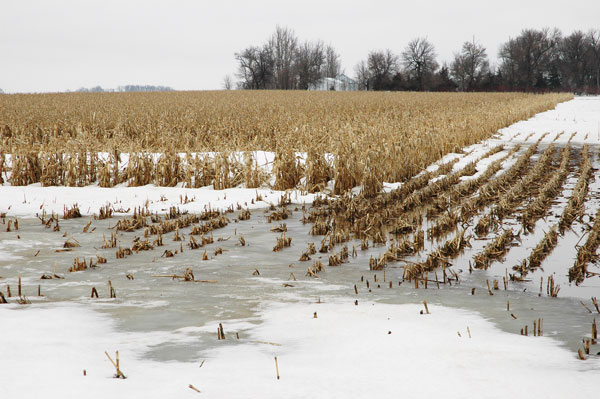January 11, 2012

Ohio State University (OSU) reports that livestock producers across Ohio and other parts of the Midwest have been unable to apply manure during the fall and early winter due to saturated field conditions. The end result is that many livestock producers in these parts of the country are pressed for manure storage room. Waiting for frozen ground on which to apply manure is likely to be their only available option, according to OSU experts.
Producers are being encouraged to plan carefully before spreading manure on frozen and snow-covered ground to make sure they minimize possible impacts on water quality. Constant changes in weather are typical of winters in Ohio, which increases the potential for manure to move with surface runoff. Runoff can lead to polluting water resources including streams, waterways and wells. Not only does this impact water quality, the nutrients are lost and not available for the next year’s crop.
OSU agronomic crop team experts say the U.S. Department of Agriculture (USDA) Natural Resources Conservation Service (NRCS) Practice Standard 633, “Waste Utilization” outlines the best management practice (BMP) to reduce the potential of manure moving off-site. This Practice Standard will also help producers recycle nutrients more efficiently, thus reducing the need for commercial fertilizer. Although Best Management Practices can help reduce the risk of pollution, it is important to keep in mind that the potential for manure run-off increases during winter application. This is why winter application of manure is not recommended and should only be practiced as a last resort.
When manure is applied on frozen or snow-covered soils, only enough manure should be applied to address storage limitations and only when all of the following criteria are met:
· Application rates are limited to 10 wet tons/acre for solid manure that is more than 50% moisture and five wet tons for manure less than 50% moisture. For liquid manure, the application rate is limited to 5,000 gal./acre.
· Applications should be made on land with at least 90% surface residue cover such as good quality hay fields or pastures, fields where all corn grain residues are remaining after harvest, locations where all wheat residue cover is remaining after harvest or fields with well-established cover crops.
· Manure shall not be applied on more than 20 contiguous acres. Each 20-acre block should be separated by a break of at least 200 ft.
· Utilize field which are farthest from streams, ditches, waterways, surface inlets, etc. and are least likely to have manure move in a concentrated flow toward and into water resources.
· Increase the application setback distance to a minimum of 200 ft. from environmentally sensitive areas and areas of concentrated flow such as grassed waterways, surfaced drainage ditches, streams, surface inlets and water bodies. This distance may need to be greater when local conditions warrant, such as fields with more slopes.
· For permitted facilities, setbacks should be 300 ft. from wells and residences.
· OSU suggests manure applied on frozen or snow-covered ground should not exceed the nitrogen need of the next growing crop, or the crop removal rate for phosphorus for the next crop (not to exceed 250 lb./acre), or the crop potassium needs (not to exceed 500 lb./acre) or 10 wet tons less than 50% moisture; five wet tons greater than 50% moisture, or 5,000 gallons of liquid manure per acre. Application rates are based upon the most limiting of these options.
According to OSU, on fields with slopes greater than 6%, manure should be applied in alternating strips 60 to 200 feet wide generally on the contour, or in the case of contour strips, on alternating strips at rates identified above. Application rates and cover and setback requirements also apply.
Winter application should not be part of a manure management plan and it should only be viewed as a last resort. The OSU team reminds producers if manure application during winter is necessary, pre-planning to avoid fields where potential runoff could enter water passages will reduce pollution.
Some states have prohibited manure application on frozen or snow-covered ground but it is still an option with very careful management in Ohio. More information on winter manure application can be found through a local NRCS or Soil and Water Conservation District office, or through the USDA-NRCS Practice Standard 633. For more OSU manure management information visit http://oema.osu.edu.
You May Also Like



